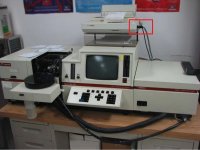Varian_chemist
New Member
- Joined
- Sep 23, 2023
- Messages
- 6
Hello!
I operate a survivor chemical analysis apparatus: a Spectraa 10 +. It was on the market for the first time in 1984. Works fine and gives accurate results. After research, I try to fit a printer with it, the original one was gone. In the manual, they indicate to use a Epson RX-80, LX-80 or MX-80. So I bought a Epson LX-350, same pinter data language ESC/P. Printer works fine, but the Spectraa only detect if the printer is online (E 81 printer offline or not connected) or when I try to print : E 82 printer out of paper. So unable to print chemical results. I use a female to female DB25 adaptator, DB 25 on the Spectraa is male and cable too, and a DB-25 to Centronics connector (CN 36) to connect to the printer. I try two sets of adaptor/cable same result. I try to use a DB 25 serial cable at both end: Spectraa doesn't detect the printer (E 81). If someone have some ideas to solve the problem, they are welcome.
see this youtube video about Spectraa by Varian: Varian Spectraa with Max Gillies. 1984

I operate a survivor chemical analysis apparatus: a Spectraa 10 +. It was on the market for the first time in 1984. Works fine and gives accurate results. After research, I try to fit a printer with it, the original one was gone. In the manual, they indicate to use a Epson RX-80, LX-80 or MX-80. So I bought a Epson LX-350, same pinter data language ESC/P. Printer works fine, but the Spectraa only detect if the printer is online (E 81 printer offline or not connected) or when I try to print : E 82 printer out of paper. So unable to print chemical results. I use a female to female DB25 adaptator, DB 25 on the Spectraa is male and cable too, and a DB-25 to Centronics connector (CN 36) to connect to the printer. I try two sets of adaptor/cable same result. I try to use a DB 25 serial cable at both end: Spectraa doesn't detect the printer (E 81). If someone have some ideas to solve the problem, they are welcome.
see this youtube video about Spectraa by Varian: Varian Spectraa with Max Gillies. 1984



